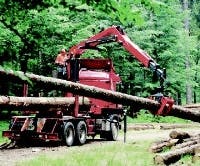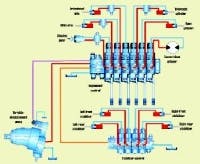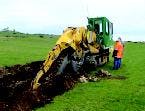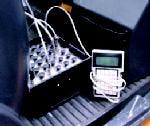In today's mobile equipment, multiple implements must operate simultaneously, yet with precise control. Valves must handle changing loads and flows even though loads and motions change continually.
It's no secret that mobile equipment manufacturers want hydraulic controls that simplify designs, yet are versatile enough to handle a wide range of applications. Modular load-sensing valves fit this bill and are an increasingly popular alternative to traditional monoblock valves.
The latest generation of load-sensing directional-control valves incorporates both flow and pressure control into sandwich-style units. Although equipment operations can be controlled by either flow or pressure, doing so generally requires additional external plumbing that increases complexity and cost. Placing flow and pressure control within the same valve simplifies hydraulics, gives designers more flexibility, and reduces the number of components and connections — which improves reliability.
Valves offer versatility
One example of the latest generation of valves is the M4, from the mobile Hydraulics Div. of Bosch Rexroth, Wooster, Ohio. Jonathan Brokaw, of Bosch Rexroth, says the pressure-compensated directionalcontrol valve is designed for medium-and high-pressure duty on forestry, agricultural, and construction equipment. Its mechanical stroke limiters allow setting maximum flow. Moreover, load-sensing pressure limiters on each port can maintain constant flow under varying loads. This ensures that valves deliver just the right flow to each function, independent of the total load on the hydraulic system.
In a crane, for example, hydraulics powers outriggers for leveling and stabilizing, extends, retracts, and rotates the boom, etc. Brokaw explains that the valves precisely control hydraulic motor speed and cylinder position for each operation over a wide range of loads and speeds.
He says the M4 valve also has load ports that can include a companion measuring port for sensing real-time flow and pressure. Optional relief valves on work ports protect systems from shock, pressure spikes, and cavitation.
Three valve sizes, M4-12, M4-15, and M4-22, accommodate flows of 35, 53, and 105 gpm, respectively. Because pressure and flow demands usually differ not only from one type of machine to another, but for different functions on the same machine, designers can stack different-size M4 valves together. As many as ten size 12 and 15 valves or eight size 15 and 22 valves can be ganged together in a single, sealed unit.
All three versions offer opencenter control for fixeddisplacement pumps and closed-center control for variable-displacement pumps. Each valve operates in manual, hydraulic, or electric mode with discrete (on-off) shifting or proportional control.
Handlever mechanical overrides on each valve section work with electrical or hydraulic actuation in two ways. When engaged, the lever follows every movement of the control spool. Operators use this visual feedback for safety. When disengaged, the lever remains stationary as the valve cycles. This generates friction and hysteresis for fast reaction times and high accuracy without requiring position feedback on the valve spool.
Electronic control
Electrohydraulics brings finer control, greater safety, sophisticated diagnostics, and easier operation to mobile equipment. In addition, software tools can speed design and commissioning. Development and diagnostic software usually has Windows-based graphic interfaces and uses highlevel block programming based on IEC 61131-3. Software modules are available for most standard functions and applications, including:
- timers and Flash downloads
- standard routines, including ramps, curves, and PID control
- applications, such as drive programs with load-limiting control.
Designers mate electronics to load-sensing valves using either of two methods — through external controllers or on-board electronics. External devices, such as Bosch Rexroth's RC family, use 16-bit controllers for open and closedloop control and accommodate analog and digital input and output signals.
Pulse-width-modulated solenoid outputs produce proportional control with high positioning accuracy and low hysteresis. The design withstands vibration, temperature extremes, water and dirt, and electromagnetic interference — key features of any mobile controller.
A potential drawback to external control is complex wiring, especially if equipment uses point-topoint wire harness connections. However, many electronically controlled hydraulic applications now rely on CANbus, an open architecture that uses only four wires to connect devices in a serial daisy chain. It significantly simplifies communication networks.
Electronic control can also be built into the valve. Bringing control closer to the action offers several advantages, including:
- faster response and lower hysteresis, for greater precision
- simpler wiring than with external control
- off-load processing tasks from a central controller.
On-board valve electronics do not eliminate the central controller, but they can permit a smaller and less-costly one. Onboard control supplements the main unit by executing CANbus
commands and providing operating feedback. Ganged valve modules also act as a single unit in the CANbus daisy chain, further simplifying wiring.
Multitasking hydraulics
This application diagram indicates how load-sensing valves control multiple implements in a truck-mounted crane.
A typical application for M4 valves is on a truck-mounted loading crane. A single, variable-displacement pump supplies the six-section valve that controls various crane functions:
- main arm
- articulated arm
- telescopic cylinder
- open gripper
- close/lower gripper
- slewing (rotation).
A key requirement is that these functions operate simultaneously, yet with precise control. The valves must handle changing loads and flows even though hydraulic demands vary, depending on materials being handled and the nature of movement.
In such applications, variable-displacementpumps hold an advantage-over their fixed-displacement counterparts. Fixed-displacement pumps always deliver the same flow, regardless of demand. So if the crane sits idle, all fluid flows to the reservoir, which wastes energy and builds unwanted heat..
Variable-displacement, loadsensing pumps, however, provide only the flow required by operations at the valve. To save energy, pump displacement to shifting the pump in a low-pressure, standby mode until one or more functions demands flow. This improves system efficiency.
For safety reasons, static controls that stabilize the truck typically rely on a different set of valves.
Seal has zero tolerance for leakage
Environmental regulations in a wetland served as the impetus for a mid-sized maker of hydraulic trench diggers to trade in an off-the-shelf seal for a custom-designed one. The trench diggers leaked very little hydraulic oil, but in a protected wetland environment they could not leak even one drop.
American High Performance Seals, Oakdale, Pa., developed a new seal for a 5-in.-diameter piston rod on a hydraulic cylinder that operates a machine's dredger bucket. The rod strokes at 18 ft/min under fluid pressure to 5000 psi at outdoor temperatures from 40° to 100° F. AHP Seals used the most durable elastomer material available, high-performance polyurethane material resistant to both hydraulic fluids and wear. Engineers made a minor modification to the seal's geometry to increase its stability under varying operating conditions — even under shock loading. The resulting seal ensures that the trencher operates leak-free in any environment for long periods in an application where any leakage is unacceptable.
For more information on custom designed seals, call (412) 788-8816 or visit www.ahpseals.com
On -board instrument aids data acquisition
The SmartDrive Canalogger is designed and packaged for on-board use, so it can be installed on mobile prototypes tested in the most adverse conditions. It also uses PC Canalogger Explorer software to manage-the input, recording, and transmission of information.
Major features of the SmartDrive Canalogger include :
- 12 analog inputs,
- five frequency inputs
- eight temperature inputs,
- eight digital inputs,
- a CAN bus plug
- a handheld terminal plug for downloading data to a PC. Data can also be saved to a Smart Media Card.
For details, call (262) 321-0676 or visit www.poclainhydraulics.com





